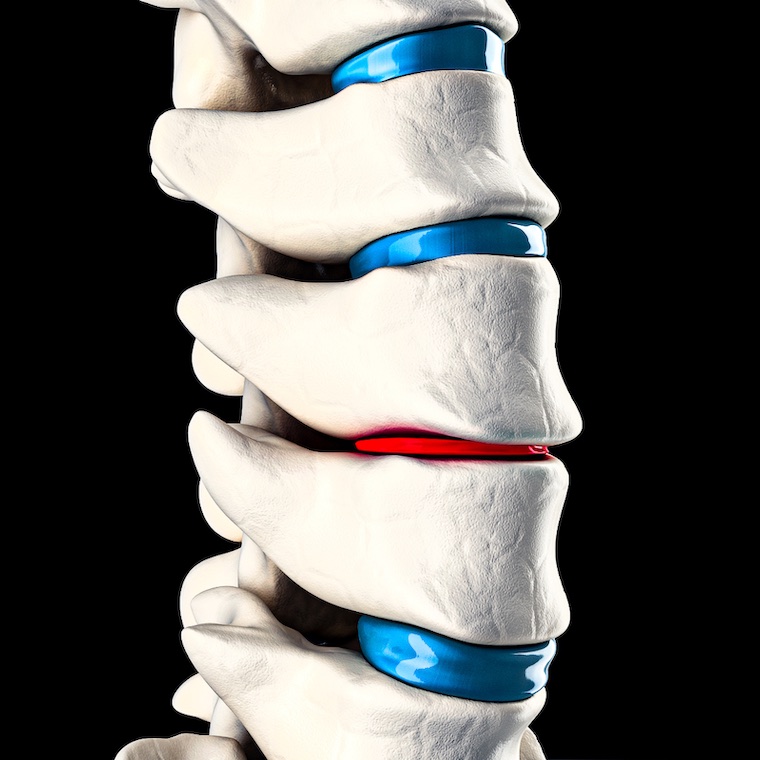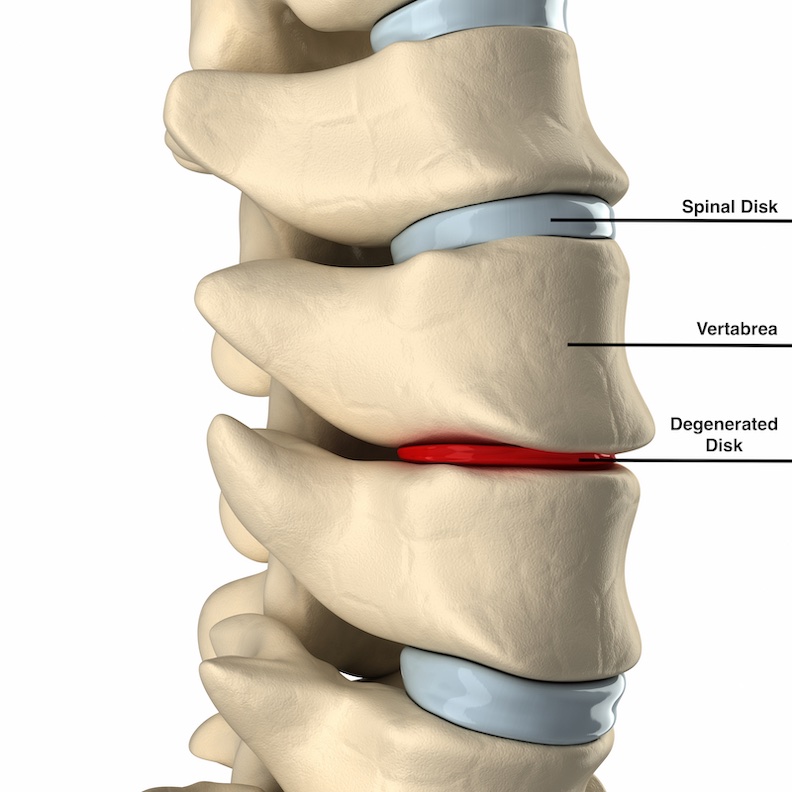Degenerative disk disease refers to back pain caused by the wearing down of the disks in the spine. An incredibly common condition that is part of the natural aging process in all of us.

Degenerative disk disease is incredibly common with almost everyone experiencing disk degeneration after the age of 40. However, Degenerative disk disease isn’t actually a disease but describes a condition where a damaged spinal disk causes pain. The spinal disks are the rubbery cushions in between the bones in the spine (Vertebrae).
In a healthy spine, the disks act as a shock absorber between the bones helping you to move and bend comfortably. Over time, as we age, the disks become less spongey and become more brittle causing them to degenerate and become smaller. When they wear away like this the bones can start to rub together becoming painful and inflamed.
It is also important to note that degenerative disk disease is different from arthritis of the spine. Arthritis of the spine may occur at the same time, contribute to the pain or be a result of degenerative disk disease but Arthritis impacts the vertebrae, not the spinal disks.


Degenerative disk disease immediately sounds like the symptoms will get worse as things ‘deteriorate’. However, the term is not referencing the symptoms but is describing how the disk in the spine is degenerating over time.
The biggest indicator of degenerative disk disease is a dull constant pain around the degenerating disk that may sometimes flare up and become more severe.
An increase in your pain could be down to a recent increase in activity or stress through the spine, or it may start suddenly with no obvious cause. A flare-up of pain from degenerative disk disease can last from a few days to several weeks before it returns to its base level, or in some cases, temporarily goes away completely.
Common symptoms of degenerative disk disease include:
Sitting for prolonged periods of time can increase your pain and symptoms. This is because when you are seated, the disks in the lower back are taking up to three times more load through them compared to when you are standing.
Moments such as bending or twisting can increase your levels of pain. This is magnified if you are carrying weight at the same time.
An indication of degenerative low back pain can also be the things that ease your pain.
Walking. Often you feel a reduction in your pain and symptoms when you are walking, or even running, compared to sitting or standing.
Changing position or lying down, sometimes with a pillow under your knees, can change the direction of the loading though the spine and elevate your pain and symptoms.

Degenerative disk disease does not always cause pain or symptoms. Pain is caused by the degenerated disk impacting other structures in the spine such as the muscles, ligaments, tendons or nerve roots.
Inflammation in the disk space happens as the disk degenerates. As the fluid leaks out this can cause swelling in the different structures around it causing muscle pain and spasms as well as localised pain and tenderness. It can also contribute to some of the radiating signals if the nerve becomes inflamed and irritated.
Nerve root compression accounts for the radiating symptoms down the arms or legs. The nerve comes out of the spine through a small gap between two of the vertebral bones, with degenerative disk disease this gap narrows and reduces the space, squashing the nerve.
Micro instability of the vertebrae. The disks in the spine act as shock absorbers to the spine but with degenerative disk disease, they lose this cushioning which leads to small unnatural movements. This causes localised irritation to the structures around and can also trigger protective muscle spasms.
Ice. Applying ice to the area can help reduce pain and inflammation in the area reducing the swelling and irritation to the structures in the lower back.
You want to apply ice for at least 20 minutes to allow the cooling effects to penetrate the deeper structures.
You can apply ice frequently throughout the day for pain relief but a good rule is 20 minutes per hour, this will give the body time to rest and prevent any freezing injuries.
Heat. Applying radiating heat to the back such as the Riixo back brace or a hot bath can help to relax the surrounding muscles and reduce the pain caused by any muscle spasms. You will want to avoid any heating creams as these do not penetrate deep enough to help.
Apply heat to the area for at least 20 minutes, this will be long enough to elicit a physiological response.
Medication can help manage your symptoms but you are advised to speak with your doctor or pharmacist about which ones to take and what doses.
Steroid Injections may be an option offered to you by your doctor as a way to reduce pain. This is not intended to fix the problem but it could give you a window of time where you are relatively pain-free. The aim it to enable you to implement an activity or exercise program to help maintain strength and mobility to reduce your levels of pain.
The information on this site is intended for educational purposes.
You must not rely on the information on this website as an alternative to medical advice from your doctor or other professional healthcare provider. If you have any specific questions about any medical matter you should consult your doctor or other professional healthcare provider. If you think you may be suffering from any medical condition you should seek immediate medical attention. You should never delay seeking medical advice, disregard medical advice, or discontinue medical treatment because of information on this website.
No Thanks – I’ll pay full price
Close Window
Close Window